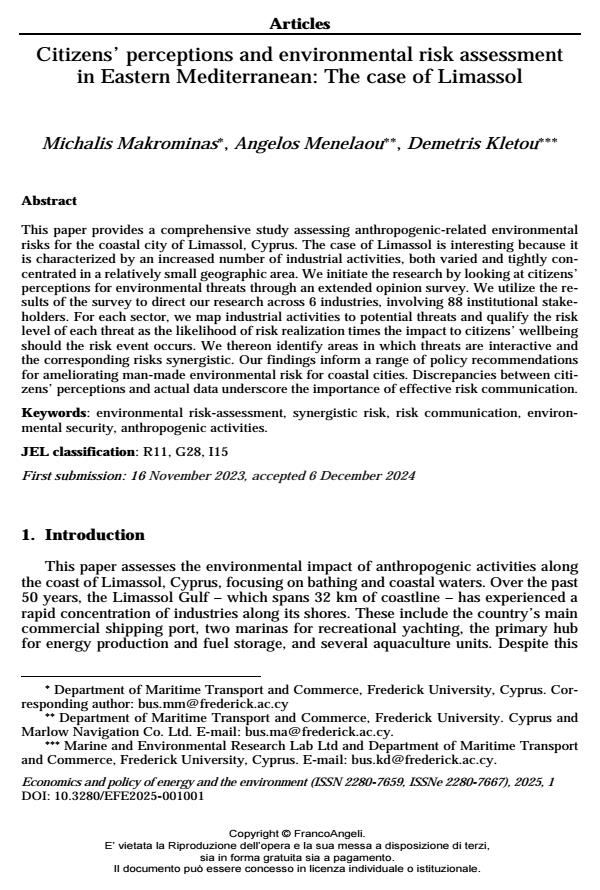Citizens’ perceptions and environmental risk assessment in Eastern Mediterranean: The case of Limassol
Titolo Rivista ECONOMICS AND POLICY OF ENERGY AND THE ENVIRONMENT
Autori/Curatori Michalis Makrominas, Angelos Menelaou, Demetris Kletou
Anno di pubblicazione 2025 Fascicolo 2025/1
Lingua Inglese Numero pagine 32 P. 5-36 Dimensione file 561 KB
DOI 10.3280/EFE2025-001001
Il DOI è il codice a barre della proprietà intellettuale: per saperne di più
clicca qui
Qui sotto puoi vedere in anteprima la prima pagina di questo articolo.
Se questo articolo ti interessa, lo puoi acquistare (e scaricare in formato pdf) seguendo le facili indicazioni per acquistare il download credit. Acquista Download Credits per scaricare questo Articolo in formato PDF

FrancoAngeli è membro della Publishers International Linking Association, Inc (PILA)associazione indipendente e non profit per facilitare (attraverso i servizi tecnologici implementati da CrossRef.org) l’accesso degli studiosi ai contenuti digitali nelle pubblicazioni professionali e scientifiche
This paper provides a comprehensive study assessing anthropogenic-related environmental risks for the coastal city of Limassol, Cyprus. The case of Limassol is interesting because it is characterized by an increased number of industrial activities, both varied and tightly concentrated in a relatively small geographic area. We initiate the research by looking at citizens’ perceptions for environmental threats through an extended opinion survey. We utilize the results of the survey to direct our research across 6 industries, involving 88 institutional stakeholders. For each sector, we map industrial activities to potential threats and qualify the risk level of each threat as the likelihood of risk realization times the impact to citizens’ wellbeing should the risk event occurs. We thereon identify areas in which threats are interactive and the corresponding risks synergistic. Our findings inform a range of policy recommendations for ameliorating man-made environmental risk for coastal cities. Discrepancies between citizens’ perceptions and actual data underscore the importance of effective risk communication.
Parole chiave:environmental risk-assessment, synergistic risk, risk communication, environmental security, anthropogenic activities.
Jel codes:R11, G28, I15
Michalis Makrominas, Angelos Menelaou, Demetris Kletou, Citizens’ perceptions and environmental risk assessment in Eastern Mediterranean: The case of Limassol in "ECONOMICS AND POLICY OF ENERGY AND THE ENVIRONMENT" 1/2025, pp 5-36, DOI: 10.3280/EFE2025-001001